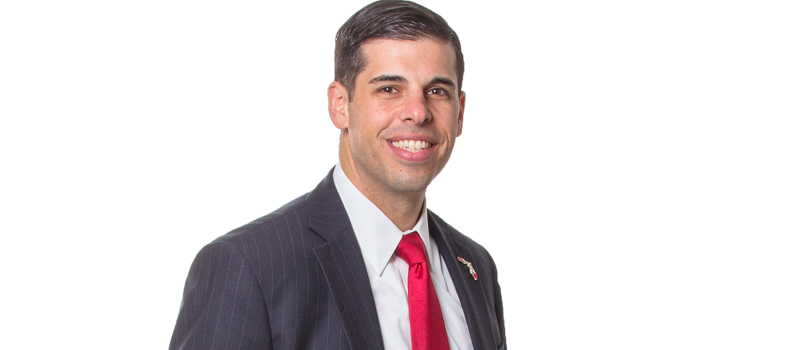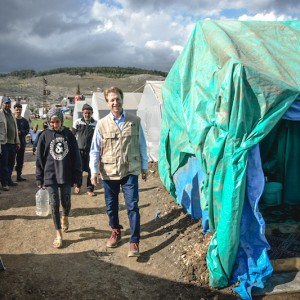Florida as of August 2015 has seen all of the jobs lost in the Great Recession replaced, and for the first time has more people employed than at the peak of the boom. “The recession is behind us,” says Jesse Panuccio, executive director of the Florida Department of Economic Opportunity [DEO]. The state leader spoke in September at the SRQ Media Group-organized event “SB2: Financial Forecast” at The Francis and then sat down with the magazine to discuss how Florida is preparing for growth in commerce, workforce skills and, most especially, in jobs.

You have stressed that much of the job growth in Florida has been in professional jobs. What does that mean for economic diversification? Historically, Florida has had agriculture, tourism and a few industries. Florida has a very important base industry in hospitality, upon which we can grow. That’s how you look at it. It brings a lot of money into the state, and a lot of people, but then we have to use that money and those resources to grow into other things. Florida, if you think about it, is big enough to do anything. We have 20 million people and have an environment for any type of industry. Our overall policy orientation in Tallahassee is to promote that diversification. If you look at our competitive economic development, we have target industries: aerospace, professional services, education, health services, life sciences—all target industries. When we go and look for these big relocations and expansions, a lot of that is targeted toward more diversification. We want to grow manufacturing. Gov. [Rick] Scott has pushed for the elimination of the tax on manufacturing equipment, a specific policy going after the growth of a specific industry.
Manufacturing can also be difficult in Florida because of geography, that this is a state without many states neighboring it. How do we overcome that natural challenge? A manufacturer isn’t thinking about their market in the right way if they think that. What Florida has better than any state is we are a hub for worldwide trade. We are actually a global logistic center, if you think about proximity to Latin and South America. We have one of the best roadway infrastructures. We have good freight and rail lines. We have great airports and many of them, and 15 seaports that have had record investments in the last 15 years. Don’t just think about in-state business or U.S. business. You should be thinking about worldwide business. If that is your market, then Florida is actually a great place and better positioned than a lot of competitor states. And those manufacturers who do engage in overseas trade tend to have both higher revenues and higher wages because they’re accessing bigger markets.
You have talked about the problem with having a shrinking teenage workforce. Is that partly because some older workers have been unable to move out of those jobs normally held by teens? The declining teenage workforce participation is a longtime nationwide trend and a negative one, partially explained by more education, which is a good piece of that trend, but then explained by many other things that are not so positive. In terms of people staying in entry-level jobs longer, that was certainly true and is true in recessionary periods, and in this Great Recession that we had, it happened. But we are entering a period now where there is a lot more flexibility in the labor market and people are now feeling comfortable enough where they are able to leave a job to go look for another one. What are the reasons people are unemployed? We survey that nationwide. There are really two main categories, job losers and job leavers. Job losers are those laid off or fired. Job leavers leave voluntarily. You see during a recessionary period the percentage of job losers increase and job leavers decrease. As we have been in this recovery and now resurgence, we are seeing the inverse. The job losers are coming down in percentage and job leavers are going up. That suggests to me there is enough comfort in the labor market now that people can go out and take the next step. During the recession, job losers accounted for 57 percent of the unemployed; that’s now down to 48.6 percent. Less than a majority of those who are out of a job are losers. It’s a great sign. Again, a healthy labor market has people coming and going. Sometimes people who want to move up a ladder are going to leave, and sometimes they are not the right fit for a job and they are going to be laid off and fired. That’s all part of a healthy market, and we are starting to see percentages that are much more typical of a healthy labor market.
While jobs have come back there still seem to be issues with wages. How is the DEO addressing that? We have heard in the national press that the overall recovery nationwide has been a wage-less recovery. If you look at the numbers, to a large extent that is true. But when you think about a recession that in Florida had over a million unemployed people and almost a million jobs lost, unemployment was over 11 percent, the first thing that is going to happen is not wage growth. The first thing is people start getting back to work and finding jobs again. With a recession that was as deep and lasting as the one we had, that job growth issue is priority No 1. You have to get to the point where you pick up all of the slack in the labor market before there is going to be competition for labor again, and then increase wages. That’s a simple law of supply and demand. We are now back to a place where all those people who lost jobs, we gained all those jobs back and then some. And what we have started to see over the last year is some wage growth. We have a chart that shows in the private sector in Florida, adjusted for inflation, you can see 2.8-percent wage growth in the private sector in Florida over the year. Will that sustain? We’ll see. It’s a trend we are keeping an eye on. Now that we have a much tighter labor market you can finally see some wage growth and anecdotally you can also see a the bottom of the wage scale, some of these jobs at the bottom of the wage scale like at McDonald’s, Walmart and a few others, They are saying we are going to raise wages. Why? Because they are starting to have trouble competing for labor talent. That’s how you get wage growth. You’ve got to get the jobs first, and then we’ll see the wage growth.
Are you concerned how automation of services is affecting the market? It depends on what kind of lens you look at it through. If you look at the short term, it is always true that we get new technology in society and it dislocates a certain segment. When we went from horse-and-buggy to automobiles, horse-and-buggy drivers were out of a job, but they eventually came up with things like bus drivers and taxi drivers. As we go from traditional taxi model to the Uber model, you can see some dislocation. So society innovates and creates overall, I think, more prosperity. That creates other jobs. As we have automated cashiers at these terminals, yes, you won’t have cashiers anymore, but for every one of those terminals you will need somebody that knows how to service those terminals—a higher wage and higher skill job as a computer specialist. Society is pretty good at inventing, and markets work pretty well. Over time, other better jobs will come about. It can be a fearful thing, and it can be a hard thing for those that are immediately dislocated. What we have to do as a state and as a region here is make sure you have worker re-education programs so that when they do lose their jobs to innovation, maybe in a six-month program or year-round program, or get a two-year degree, we can get what society is now valuing.
Our local governments have struggled with what to do with services like Uber. Will we be seeing regulation at the state level? I think innovation is a wonderful thing. This is what they call the Gig economy and Share economy, with Uber-type, AirBNB-type apps. All these apps are tremendously popular, and they are popular for a reason; they provide a service people want and a service that is useful. Again, I’m a believer in markets and markets should be allowed to flourish and grow. Now, we in government have a responsibility to participate in matters of public health, safety and welfare, but that shouldn’t be confused with economic protectionism. Those are different things. So we have to be careful. There is going to be regulation of industries, but we have to be careful to distinguish between what is truly public health and safety, and what is economic protectionism. Gov. Scott has said recently he thinks it probably is time for a statewide solution to this rather than having a bunch of individual regulations. But honestly, we’re going to see what gets introduced. Legislative debate is good. It will provide some clarity to this issue, and then we’ll hear both sides and find out what kind of a bill comes out. I don’t want to get out ahead of that and say what I think a bill should look like, but I think we’ll see some good ideas come out of the legislative session in just a few months. I do think we’ll see something. Legislative session is always interesting. We get better policy because there is debate and a back-and-forth between the executive branch and the two houses of the Legislature, but there does seem to be a growing level of support for some kind of legislative enactment.
How important are seaports like Port Manatee to state commerce? Absolutely critical. Our ports are a major resource for the State of Florida. If you think about what makes for a growing, sustainable, prosperous economy, it’s overall economic policy tax policy and regulatory policy, but it’s also investing in the right places. Transportation infrastructure is how we move goods and people around. It’s critical if you look at this; we are at a moment in history for Florida— and for the world really—in terms of sea trade. The Panama Canal expansion is going to be completed very soon. When that happens, you are going to see these Panamax ships coming through and see a lot more traffic. They are expecting a 25-percent increase in traffic over the next 10 years in Panama Canal traffic. Those business relationships, where they go trade, that is going to establish very quickly, and if our ports aren’t ready we are going to miss out on that for years to come, so the dredging of our ports, getting Miami to 50 feet, getting that tunnel built, getting Jacksonville dredged, getting Port Everglades ready, and over here Port Manatee and Port of Tampa, all of that is important. What you’ve seen from Gov. Scott and the Legislature over the past five years is record investments. We’ve never invested as much in our ports as we have now. It’s a critical moment. We’ve done the right things. Part of the problem is federal. The Army Corps can be slow with some of the permits that we need. But luckily in last year’s water bill, we were able to get a provision in there that allows us to front the money and get repaid later, so we are doing things. This is something where you see bipartisan agreement. If you look at our Congressional delegation, what they did up there for the water bill was really important for the state. We are, wherever possible, trying to position ourselves to be ready. Of course, air travel is very important, and we have very good freight rail in our state. We have some of the best highways in the country in terms of quality. We have so many airports of such high quality. That’s critical as well, and that’s critical for getting the people here visiting.
What does Southwest Florida have specifically in terms of assets to keep it competitive? If you look at some statewide growth rates, you do see the growth rates in Southwest Florida have been very healthy. I think it’s just continuing the awareness of the region. In some ways it’s a little more undiscovered than other parts of Florida, but that’s actually a great thing. This is an area of the state that has a lot of room to grow. You need to think about how you are going to grow smartly. At DEO, we also have growth management in our purview and you need to think about how your cities grow, and you have to think what is happening in other parts of the state both good and bad and learn from them. I’m a big believer in having excellent, high-quality urban cores, where Millennials want to live right now, and where a lot of retirees are moving back to as well. Look around the country at the great cities where people want to move to. What made them attractive and made them successful? Think about that as you grow your city centers here, and also then your suburbs and your outlying region as well. How can you have them grow in a way that 20 years from now you are going to be proud of that growth and still want to live here?
Among environmentalists, there is still heartburn that the Department of Community Affairs was rolled into the DEO. How do you balance attracting growth and preventing sprawl? First, let’s look historically. If you look at the growth management laws that came into place in Florida in the late 1970s and the early 1980s, most municipalities had very little professional growth management staff. It was still a field coming into its own. The growth management acts were put into place to mandate that municipalities and localities started having that professional staff. Because it was just developing, you had this state-level review for many years. The fact that 30 years later we could take some of that state-level review away and create the DEO was really reflective of the success of those earlier laws. At this point, every municipality has a professional growth management staff that understands modern growth management principles and everybody has their master plan in place. So like everything, you shouldn’t just put something in place, have success and then leave it in place forever. What we have now is more local control of growth management, but it is local control anchored in professional growth management staffs that understand these principles of mixed use and smart growth. I think that was a totally appropriate move. When talking Uber and sharing apps and all that, you don’t want to conflate protectionism versus real public safety and public health regulation. Same thing here. Let’s not conflate principles of not-in-my-backyard with real conservation and smart growth, and sometimes that happens.









